Church History
The church building and its history
According to the Domesday Book, William of Warenne held land at Little Canfield formerly held by two free men. This estate included one priest and one mill plus assorted pigs, sheep, cattle and goats. The manor house for this part was Little Canfield Hall. Geoffrey de Mandeville also owned land at Little Canfield, including the Manor House of Langthorns. The third manor house was Stone Hall. All three houses remain to this day.
An account in 1770 states, ‘the church, a small fabric at a little distance from the Stane-Street, is of one pace only, as likewise is the chancel; both which are tiled. A small belfry, with a wooden spire, leaded, contains three bells.’ ‘Upon the north side the chancel is a vestry, ascended by nine steps, over the door of which is the following inscription:’ –
This vestry,
With the vault underneath it,
Designed for the burial-place of himself and family,
Was erected by James Wyatt, esq.
In the year 1757;
Who also in the following year
Contributed the sum of sixty guineas
For completing the ceiling of the church
And the covering the spire with lead.
The church has evolved over the centuries. 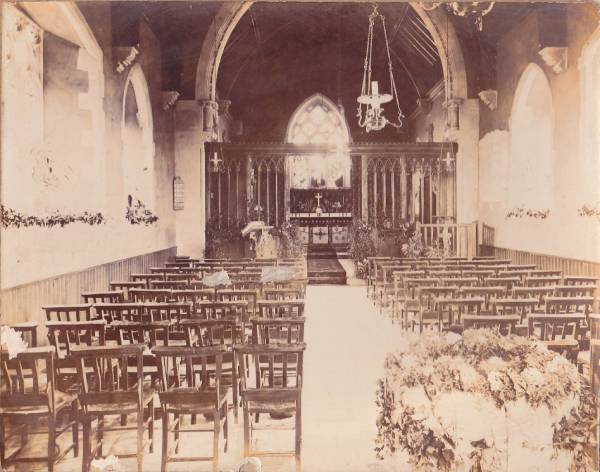 We do not know if the building described in 1770 was the same one mentioned in the Domesday Book in 1086, but certainly there were great changes when Charles Lesingham Smith was Rector of the parish between 1839 and 1878. He published a book of poems in 1870 which included ‘The Village School’, ‘The Village Feast’ and ‘The Village Church’. The village feast was an annual event in the Rectory garden, to which every villager and some other local characters were invited. We have a newspaper report which records that at one village feast at Little Canfield Rectory those present included a young ‘Daisy’ Maynard, later Countess of Warwick, who threw sweets to the village children. ‘The Village Church’ describes the building and furnishings as they were then in some detail. You will find below details of some subsequent changes and additions,
We do not know if the building described in 1770 was the same one mentioned in the Domesday Book in 1086, but certainly there were great changes when Charles Lesingham Smith was Rector of the parish between 1839 and 1878. He published a book of poems in 1870 which included ‘The Village School’, ‘The Village Feast’ and ‘The Village Church’. The village feast was an annual event in the Rectory garden, to which every villager and some other local characters were invited. We have a newspaper report which records that at one village feast at Little Canfield Rectory those present included a young ‘Daisy’ Maynard, later Countess of Warwick, who threw sweets to the village children. ‘The Village Church’ describes the building and furnishings as they were then in some detail. You will find below details of some subsequent changes and additions,
Dedication
The original dedication of the Parish Church being unknown, the church was re-dedicated to All Saints 25th February 1900 by the Bishop Suffragan of Colchester.
This sepia photograph of the interior appears to have been taken at Harvest (judging by the hymn numbers and flowers) between 1900 and 1937.
The floor and wooden chairs
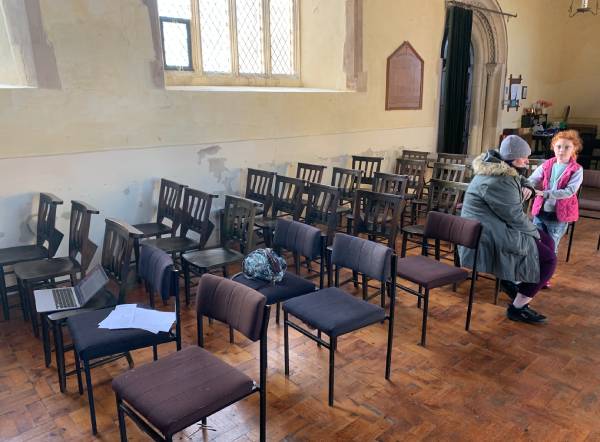 On Friday 29th June 1900, The Chelmsford Chronicle stated, ‘A Garden party and sale of work, in aid of the restoration fund of All Saints’ Church, was held in the Rectory ground on Wednesday afternoon and evening. A considerable work of renovation has recently been carried out at the church, under the superintendence of the Rector, the Rev. T. E. Hill, at a cost of £200, and a debt of £50 remained, to liquidate which the sale was organised.
On Friday 29th June 1900, The Chelmsford Chronicle stated, ‘A Garden party and sale of work, in aid of the restoration fund of All Saints’ Church, was held in the Rectory ground on Wednesday afternoon and evening. A considerable work of renovation has recently been carried out at the church, under the superintendence of the Rector, the Rev. T. E. Hill, at a cost of £200, and a debt of £50 remained, to liquidate which the sale was organised.
The interior of the building has been entirely modernised. A new wooden floor has been laid, the walls have been artistically painted, and the old-fashioned square pews have given place to a set of handsome chairs. Early in the present year the church was re-dedicated by the Bishop of Colchester. At the sale stalls of work were held by Mrs. Henson, the Misses Hill, Mrs. Kempthorne, the Misses Law, Mrs. Tench, Mrs. Whitfield, and the Misses Wilson; and the catering was ably managed by Mrs. Carter and Mrs. Stammers. The Rector was assisted in his work by Messrs. Arthur Dennis, Byatt, and Cummings, Dunmow; George and Chas. Raven, Little Canfield; and the churchwardens, Messrs. Fred Carter and George Stammers.
In the evening the grounds, which were decorated with a profusion of bunting, were prettily illuminated, and dancing was indulged in upon the lawn, to the strains of the Ipswich Hungarian Band. There were a large number of visitors from Dunmow and the surrounding villages.’
The Organ
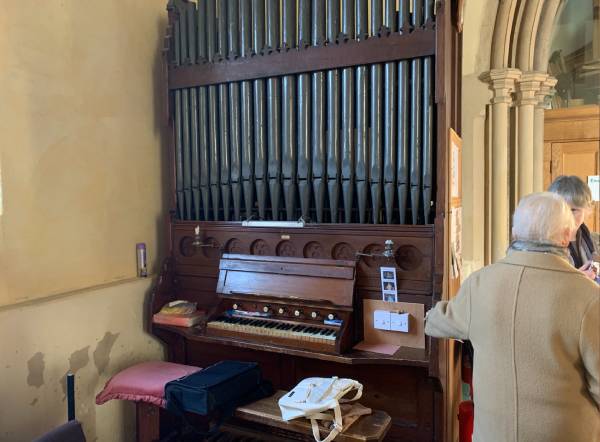
In October 1948 the renovation of the organ was in progress. The work was done by Mr Cedric Arnold of Thaxted at a cost of £28-10-0. On his advice the bourdon pipes were scrapped as virtually useless, and the swell box removed, the latter not altogether to the satisfaction of the organist!
In May 1950 an electric organ-blower was installed at a cost of approximately £50.
Electric lighting was installed in the Church on the 29th of January, 1950.
Crib Figures
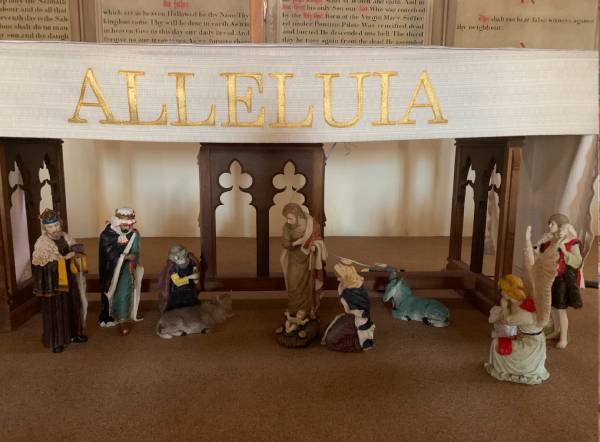
‘We look forward to seeing the Crib this year after the colours have been so skilfully and lovingly restored by Mr Harrington. This restoration has revealed their exceptional quality and real beauty. These figures, made originally in France, are a treasured possession of Little Canfield Church and are of considerable value. Mr and Mrs Ward have for many years now been responsible for setting up the Crib, which they have done with great artistry. They have longed to see the figures restored, and it must be a great joy to them to see this accomplished’ (Deanery magazine, December 1960).
Prayer desks
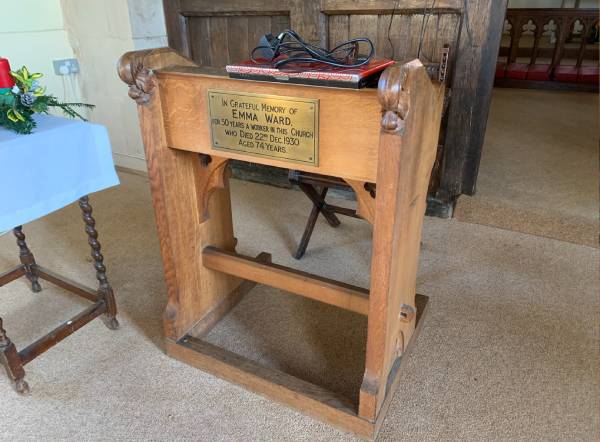
At a special service on 5 November 1931 a Prayer desk was dedicated by the Bishop in memory of Emma Ward. The desk was made by Messrs Goodey of Dunmow from local oak, and is a copy of the Rector’s desk, opposite which it was placed. The carpenter who made the desk was Alfred Perry.
It bears a plaque which reads, ‘In grateful memory of Emma Ward for 50 years a worker in this church who died 22nd. Dec. 1930 Aged 74 years’.
Pulpit
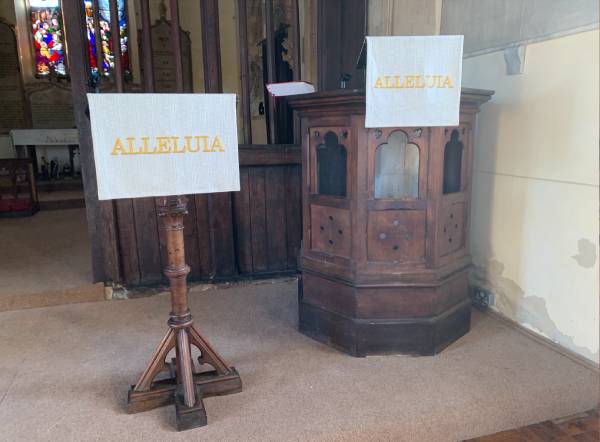
A new pulpit was installed on 20th September 1937, the gift of Captain Julian Smith, in time for Harvest Festival. This pulpit came from a dismantled City church, and had been in use at All Saints’ Hockerill whilst their services were being held in the Training College during re-building of their church after the recent fire. It was renovated and set up by Clement Joscelyne of Bishop’s Stortford at a cost of £5.
The Windows
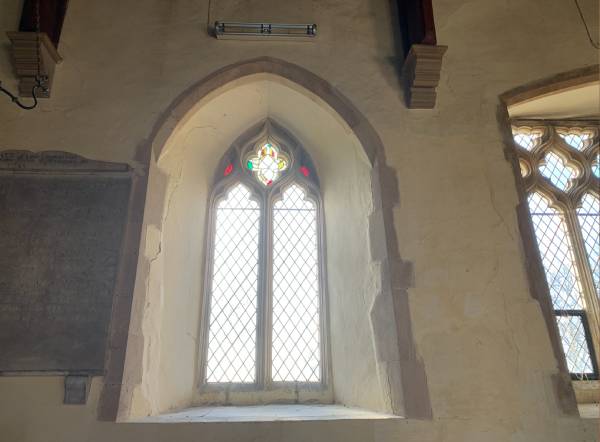
Apart from the new glazing between the vestry and chancel, our church windows are described in some detail in Charles Lesingham Smith’s poem. The only ancient glass is fragments in the east windows of the nave.
Facilities
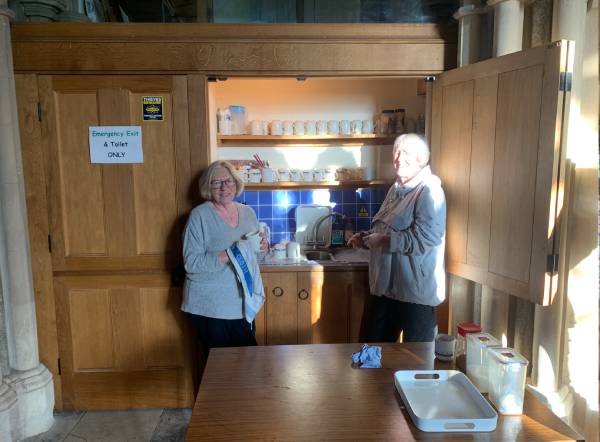
A kitchenette and toilet have been added this century, and the ropes for our four bells are now accessed from the platform above.
Summary
All Saints Church in Little Canfield has a great deal more history than detailed above! It is a grade ll listed building: “Parish Church. C12, and C14, C18 and C19. Rendered rubble with limestone dressings and red plain tiled roof. C12 Nave has four C14 windows, one with two and one with four trefoiled lights. C19 tower arch. C12 south doorway with semi-circular arch, of 3 orders, detached shafts and cushion capitals. C19 west windows. C14 Chancel now is entirely C19 internally. North vestry and vault added in 1795. North west tower and steeple added in 1856 by Rev. C.I. Smith. C14 rood screen with cusped tracery and embattled cornice. 2 brasses, 1593 and 1578. Otherwise most internal detailing is of 1856.’
The church is alive and in use for public worship; for baptisms, weddings and funerals; for quiz evenings, film nights, art exhibitions and craft workshops; and open daily for viewing, private prayer or for you to use the toilet while out on a walk in the countryside.
